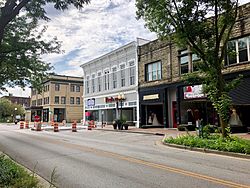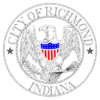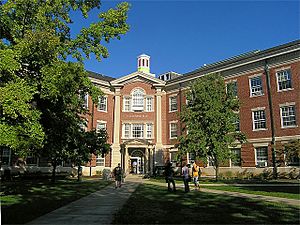Richmond, Indiana facts for kids
Quick facts for kids
Richmond, Indiana
|
|||
|---|---|---|---|

Richmond Downtown Historic District
|
|||
|
|||
| Nickname(s):
City of Roses
|
|||

Location of Richmond in Wayne County, Indiana.
|
|||
| Country | United States | ||
| State | Indiana | ||
| County | Wayne | ||
| Township | Boston, Center, Wayne | ||
| Area | |||
| • Total | 24.16 sq mi (62.56 km2) | ||
| • Land | 24.00 sq mi (62.17 km2) | ||
| • Water | 0.15 sq mi (0.39 km2) | ||
| Elevation | 978 ft (298 m) | ||
| Population
(2020)
|
|||
| • Total | 35,720 | ||
| • Density | 1,488.02/sq mi (574.54/km2) | ||
| Time zone | UTC−5 (EST) | ||
| • Summer (DST) | UTC−4 (EDT) | ||
| ZIP codes |
47374-47375
|
||
| Area code(s) | 765 | ||
| FIPS code | 18-64260 | ||
| GNIS feature ID | 2396366 | ||
Richmond (/ˈrɪtʃmənd/) is a city in eastern Wayne County, Indiana, United States. Bordering the state of Ohio, it is the county seat of Wayne County. In the 2020 census, the city had a population of 35,720. It is the principal city of the Richmond micropolitan area. Situated largely within Wayne Township, its area includes a non-contiguous portion in nearby Boston Township, where Richmond Municipal Airport is located.
Richmond is sometimes called the "cradle of recorded jazz" because the earliest jazz recordings and records were made at the studio of Gennett Records, a division of the Starr Piano Company. Gennett Records was the first to record such artists as Louis Armstrong, Bix Beiderbecke, Jelly Roll Morton, Hoagy Carmichael, Lawrence Welk, and Gene Autry. The city has twice received the All-America City Award, most recently in 2009.
Contents
History
In 1806 the first European Americans in the area, Quaker families from North Carolina, settled along the East Fork of the Whitewater River. This was part of a general westward migration in the early decades after the American Revolution. John Smith and David Hoover were among the earliest settlers. Richmond is still home to several Quaker institutions, including Friends United Meeting, Earlham College and the Earlham School of Religion.
The settlement was incorporated as a town on Sept. 1, 1818. At that time, it had 24 adult settlers. The first post office in Richmond was established in 1818.
Early cinema and television pioneer Charles Francis Jenkins grew-up on a farm north of Richmond, where he began inventing useful gadgets. As the Richmond Telegram reported, on June 6, 1894, Jenkins gathered his family, friends and newsmen at Jenkins' cousin's jewelry store in downtown Richmond and projected a filmed motion picture for the first time in front of an audience. The motion picture was of a vaudeville entertainer performing a butterfly dance, which Jenkins had filmed himself. Jenkins filed for a patent for the Phantoscope projector in November 1894 and it was issued in March of '95. A modified version of the Phantoscope was later sold to Thomas Edison who named it Edison's Vitascope and began projecting motion pictures in New York City vaudeville theaters, raising the curtain on American cinema.
Richmond is believed to have been the smallest community in the United States to have supported a professional opera company and symphony orchestra. The Whitewater Opera has since closed but the Richmond Symphony Orchestra has continued. In 1899 Will Earhart formed the first complete high school orchestra in the nation. A later high school orchestra director, Joseph E. Maddy, went on to found what is now known as the Interlochen Center for the Arts in Michigan.
Also notable was the fact that Hoagy Carmichael recorded "Stardust" for the first time in Richmond at the Gennett recording studio. Famed trumpeter and singer Louis Armstrong was first recorded at Gennett as a member of King Oliver and his Creole Jazz Band.
A group of artists in the area in the late 19th and early 20th centuries came to be known as the Richmond Group. They included John Elwood Bundy, Charles Conner, George Herbert Baker, Maude Kaufman Eggemeyer and John Albert Seaford, among others. The Richmond Art Museum has a collection of regional and American art. Many consider the most significant painting in the collection to be a self-portrait of Indiana-born William Merritt Chase.
The city was connected to the National Road, the first road built by the federal government and a major route west for pioneers of the 19th century. It became part of the system of National Auto Trails. The highway is now known as U.S. Route 40. One of the extant Madonna of the Trail monuments was dedicated at Richmond on October 28, 1928 The monument sits in a corner of Glen Miller Park adjacent to US 40.
Richmond's cultural resources include two of Indiana's three Egyptian mummies. One is held by the Wayne County Historical Museum and the second by Earlham College's Joseph Moore Museum, leading to the local nickname of "Mummy capital of Indiana".
The arts were supported by a strong economy increasingly based on manufacturing. Richmond was once known as "the lawn mower capital" because it was a center for manufacturing of lawn mowers from the late 19th century through the mid-20th century. Manufacturers included Davis, Motomower, Dille-McGuire and F&N. The farm machinery builder Gaar-Scott was based in Richmond. The Davis Aircraft Co., builder of a light parasol wing monoplane, operated in Richmond beginning in 1929.
After starting out in nearby Union City, Wayne Agricultural Works moved to Richmond. Wayne was a manufacturer of horse-drawn vehicles, including "kid hacks", a precursor of the motorized school bus. From the early 1930s through the 1940s, several automobile designers and manufacturers were located in Richmond. Among the automobiles locally manufactured were the Richmond, built by the Wayne Works; the "Rodefeld"; the Davis; the Pilot; the Westcott and the Crosley.
In the 1950s, Wayne Works changed its name to Wayne Corporation, by then a well-known bus and school-bus manufacturer. In 1967 it relocated to a site adjacent to Interstate 70. The company was a leader in school-bus safety innovations, but it closed in 1992 during a period of school-bus manufacturing industry consolidations.
Richmond was known as the "Rose City" because of the many varieties once grown there by Hill's Roses. The company had several sprawling complexes of greenhouses, with a total of about 34 acres (140,000 m2) under glass. The annual Richmond Rose Festival honored the rose industry and was a popular summer attraction.
Geography
Richmond is located at 39°49′49″N 84°53′26″W / 39.830189°N 84.890668°W.
According to the 2010 census, Richmond has a total area of 24.067 square miles (62.33 km2), of which 23.91 square miles (61.93 km2) (or 99.35%) is land and 0.157 square miles (0.41 km2) (or 0.65%) is water.
Demographics
| Historical population | |||
|---|---|---|---|
| Census | Pop. | %± | |
| 1840 | 2,070 | — | |
| 1850 | 1,443 | −30.3% | |
| 1860 | 6,608 | 357.9% | |
| 1870 | 9,445 | 42.9% | |
| 1880 | 12,742 | 34.9% | |
| 1890 | 16,608 | 30.3% | |
| 1900 | 18,226 | 9.7% | |
| 1910 | 22,824 | 25.2% | |
| 1920 | 26,765 | 17.3% | |
| 1930 | 32,493 | 21.4% | |
| 1940 | 35,147 | 8.2% | |
| 1950 | 39,539 | 12.5% | |
| 1960 | 44,149 | 11.7% | |
| 1970 | 43,999 | −0.3% | |
| 1980 | 41,349 | −6.0% | |
| 1990 | 38,705 | −6.4% | |
| 2000 | 39,124 | 1.1% | |
| 2010 | 36,812 | −5.9% | |
| 2020 | 35,720 | −3.0% | |
| Source: US Census Bureau | |||
2010 census
As of the census of 2010, there were 36,812 people, 15,098 households, and 8,909 families residing in the city. The population density was 1,539.0 inhabitants per square mile (594.2/km2). There were 17,649 housing units at an average density of 737.8 per square mile (284.9/km2). The racial makeup of the city was 83.9% White, 8.6% African American, 0.3% Native American, 1.1% Asian, 0.1% Pacific Islander, 1.9% from other races, and 4.0% from two or more races. Hispanic or Latino of any race were 4.1% of the population.
There were 15,098 households, of which 28.8% had children under the age of 18 living with them, 37.5% were married couples living together, 16.3% had a female householder with no husband present, 5.3% had a male householder with no wife present, and 41.0% were non-families. 34.2% of all households were made up of individuals, and 13.5% had someone living alone who was 65 years of age or older. The average household size was 2.29 and the average family size was 2.91.
The median age in the city was 38.4 years. 22.1% of residents were under the age of 18; 11.4% were between the ages of 18 and 24; 24.4% were from 25 to 44; 25.6% were from 45 to 64; and 16.5% were 65 years of age or older. The gender makeup of the city was 47.9% male and 52.1% female.
Points of interest
- Hayes Arboretum
- Cope Environmental Center
- Wayne County Historical Museum
- Richmond Art Museum
- Indiana Football Hall of Fame
- Gaar Mansion (house museum)
- Joseph Moore Museum at Earlham College
- Glen Miller Park and Madonna of the Trail statue
- Richmond Downtown Historic District
- Old Richmond Historic District
- Starr Historic District
- Richmond Railroad Station Historic District
- Reeveston Place Historic District
- East Main Street-Glen Miller Park Historic District
- Don McBride Stadium baseball ballpark built in 1936
- Reid Memorial Presbyterian Church (Louis Comfort Tiffany-designed interior and windows, Hook and Hastings organ)
- Bethel AME Church (oldest AME church in Indiana: founded 1868)
- Old National Road Welcome Center (convention and tourism bureau)
- Whitewater Gorge Park and Gennett Walk of Fame
- Cardinal Greenway hiking trail
- Richmond Civic Theatre (plays, classic movies, and children's theater)
- Madonna of the Trail statue at Glen Miller Park
- Gennett Records Walk of Fame
- Richmond Mall, shopping mall
Education
Richmond is home to four colleges: Earlham College, Indiana University East, Ivy Tech Community College of Indiana, and the Purdue Polytechnic Institute – Richmond. It is also home to two seminaries, the Quaker Earlham School of Religion and Church of the Brethren Bethany Theological Seminary.
Richmond High School includes the Richmond Art Museum and Civic Hall Performing Arts Center. Seton Catholic High School, a junior and senior high school, is a religious high school. It is based in the former home of St. Andrew High School (1899–1936) and, more recently, St. Andrew Elementary School, adjacent to St. Andrew Church of the Richmond Catholic Community.
The Richmond Japanese Language School (リッチモンド(IN)補習授業校 Ritchimondo(IN)Hoshū Jugyō Kō) a part-time Japanese school, holds its classes at the Highland Heights School.
The town has a lending library, the Morrisson Reeves Library.
Religious groups
Richmond is the headquarters of Friends United Meeting, and hosts the Quaker Hill Conference Center, of the Religious Society of Friends (Quakers).
Media
The daily newspaper is the Gannett-owned Palladium-Item.
Full-power radio stations include WKBV, WFMG, WQLK, WKRT, and Earlham College's student-run public radio station WECI. Richmond is also served by WJYW which is repeated on 94.5 and 97.7. Area NPR radio stations include WBSH in Hagerstown, Indiana, and WMUB in Oxford, Ohio.
Richmond is considered to be within the Dayton, Ohio, television market and has one full-power television station, WKOI, which is an Ion owned and operated station. The city also has one county-wide public, educational, and government access (PEG) cable television station, Whitewater Community Television.
Transportation
Richmond Municipal Airport is a public-use airport five nautical miles (6 mi, 9 km) southeast of Richmond's central business district. It is owned by the Richmond Board of Aviation Commissioners. It is also an exclave of Richmond. Richmond's closest airport with commercial service is Dayton International Airport.
Richmond is served by Interstate 70 at exits 149, 151, 153, and 156.
Established in 1902, Richmond's Pennsylvania Railroad station was a hub for Pennsylvania Railroad, and later, Penn Central trains into the late 1960s. The last train at the station was Amtrak's National Limited between Kansas City and New York City, which ended service in 1979. Richmond was also home to a Chesapeake and Ohio Railway station.
Public transit service is provided by city-owned Roseview Transit, operating daily except Sundays and major holidays.
Notable people
Academia
- J. Gayle Beck, clinical psychologist, Lillian and Morrie Moss Chair of Excellence and Professor at the University of Memphis
- Landrum Bolling, president of Earlham College, humanitarian, diplomat
- Mary Haas (1910 – 1996), linguist and professor at University of California-Berkeley
- Wendell Stanley, biochemist, virologist, Nobel Prize winner
Actors
- Timothy Brown, professional football player, television/film actor and recording-artist
- Norman Foster, actor, director
- Sarah Purcell, actress
- Elizabeth Reller, old-time radio actress
Artists and designers
- George Herbert Baker, Impressionist painter
- John Elwood Bundy, Impressionist painter
- Charles Fremont Conner, Impressionist painter
- Maude Kaufman Eggemeyer, Impressionist painter
- Marcus Mote, painter
- Carole Wantz, folk artist
- Gaar Williams, cartoonist
Business
- Micajah C. Henley, businessman, roller skate pioneer
- Charles Francis Jenkins, pioneer of early cinema and one of the inventors of television
- Addison H. Nordyke, industrialist and co-founder of Nordyke Marmon & Company.
- Daniel G. Reid, industrialist, financier, and philanthropist
- Burton J. Westcott, businessman, automobile manufacturer of Westcott Motor Car Company
Musicians
- May Aufderheide, ragtime composer
- George Duning, musician and composer
- Harry "Singin' Sam" Frankel, radio star, minstrel
- Baby Huey, rock and soul vocalist
- Jeff Hamilton, jazz drummer
- Harold Jones, has performed with many notables, including Tony Bennett and Count Basie
- Melvyn "Deacon" Jones, blues organist
- Rich Mullins, singer/musician
- Sondra Radvanovsky, opera singer
- Ned Rorem, composer and Putlizer Prize winner
- The Will-O-Bees, pop music trio in the 1960s
Politicians, activists, and civic leaders
- Bill W. Balthis (1939 – 2016), Illinois state representative and businessman
- Thomas W. Bennett, Richmond mayor, Governor, congressional delegate of Idaho territory.
- John A. Bridgland (1826–1890), diplomat, businessman and soldier; colonel in the Union Army
- Levi Coffin, underground railroad organizer, and director of a local Richmond bank
- David W. Dennis, U.S. Congressman
- Jehu Elliott, Justice of the Indiana Supreme Court
- Gregory Lee Johnson (born 1956), American political activist.
- John F. Kibbey, Indiana Attorney General
- Ida Finney Mackrille (1867 – 1960) suffragist and a women's political leader in the State of California.
- Dan Mitrione, Richmond police chief from 1956 to 1960, and U.S. adviser who trained police in the use of torture in Uruguay.
- Oliver P. Morton, Indiana's Civil War governor
- Susan Porter Rose, Chief of Staff to the First Lady of the United States (1989–1993)
- John Wilbur Chapman, Presbyterian evangelist
- Jim Jones, founder-leader of Peoples Temple
- William Paul Quinn, an African Methodist Episcopal Bishop
- D. Elton Trueblood, Quaker theologian
Science
- Charles A. Hufnagel, M.D. artificial heart valve inventor
- Wright brothers, aviation pioneers
Sports
- Desmond Bane, NBA, Selected 30th overall by the Memphis Grizzlies in the 2020 NBA draft
- Claude Berry, MLB catcher
- Weeb Ewbank, coach of 1958 and 1959 NFL champion Baltimore Colts and the Super Bowl III champion New York Jets
- Vagas Ferguson, NFL running back
- Paul Flatley, NFL wide receiver (Minnesota Vikings)
- Del Harris, professional basketball coach
- Daniel Kinsey, hurdler, Olympic gold medalist
- Jim Logan
- Lamar Lundy, football player, one of the L.A. Rams' "Fearsome Foursome"
- Bo Van Pelt, professional golfer
Writers and journalists
- Christopher Benfey, literary critic
- Mae Bramhall, actress, writer
- William Dudley Foulke, lawyer, author
Sister cities
 Serpukhov, Russia
Serpukhov, Russia Unnan, Shimane Prefecture, Japan
Unnan, Shimane Prefecture, Japan
See also
 In Spanish: Richmond (Indiana) para niños
In Spanish: Richmond (Indiana) para niños






